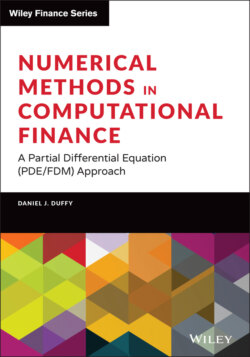Читать книгу Numerical Methods in Computational Finance - Daniel J. Duffy - Страница 72
4.4 LINEAR INDEPENDENCE AND BASES
ОглавлениеWe are now interested in finding a minimal subspace U of independent vectors containing a set X (U contains X) such that any vector in X can be written as a linear combination of these vectors. In this case we say that X spans U. We are particularly interested in the case , that is subsets of that span itself. Such subsets always exist; for example has this property. We take an example in n-dimensional space. The vectors:
(4.14)
span because each element can be written as a linear combination:
Furthermore, any proper subset of cannot span .
Another example is the vector space generated by polynomials of the form of Equation (4.11) generated the monomials . It is clear that any proper subset of this set spans a proper subspace of ; it cannot span itself.
Definition 4.1 A vector is linearly dependent on a given subset X of if x belongs to the subspace generated by the set X.
Definition 4.2 A subset X of is called a linearly dependent set if it contains at least one element that is linearly dependent on the others.
Definition 4.3 A set is called linearly independent if it is not linearly dependent.
The elements as defined in Equation (4.14) form a linearly independent set in , and adjoining any other vector to this set makes it linearly dependent.
Summarising, the criterion for linear independence is:
(4.15)
Definition 4.4 A basis of a vector space is any linearly independent subset of which has the property that it spans .
Definition 4.5 The dimension n of (denoted by dim V) is the supremum of the (cardinal) numbers of elements in the linearly independent subsets of .
is said to be finite-dimensional if n is finite. In this case there exist linearly independent subsets with n elements but no linearly independent subsets with elements.
